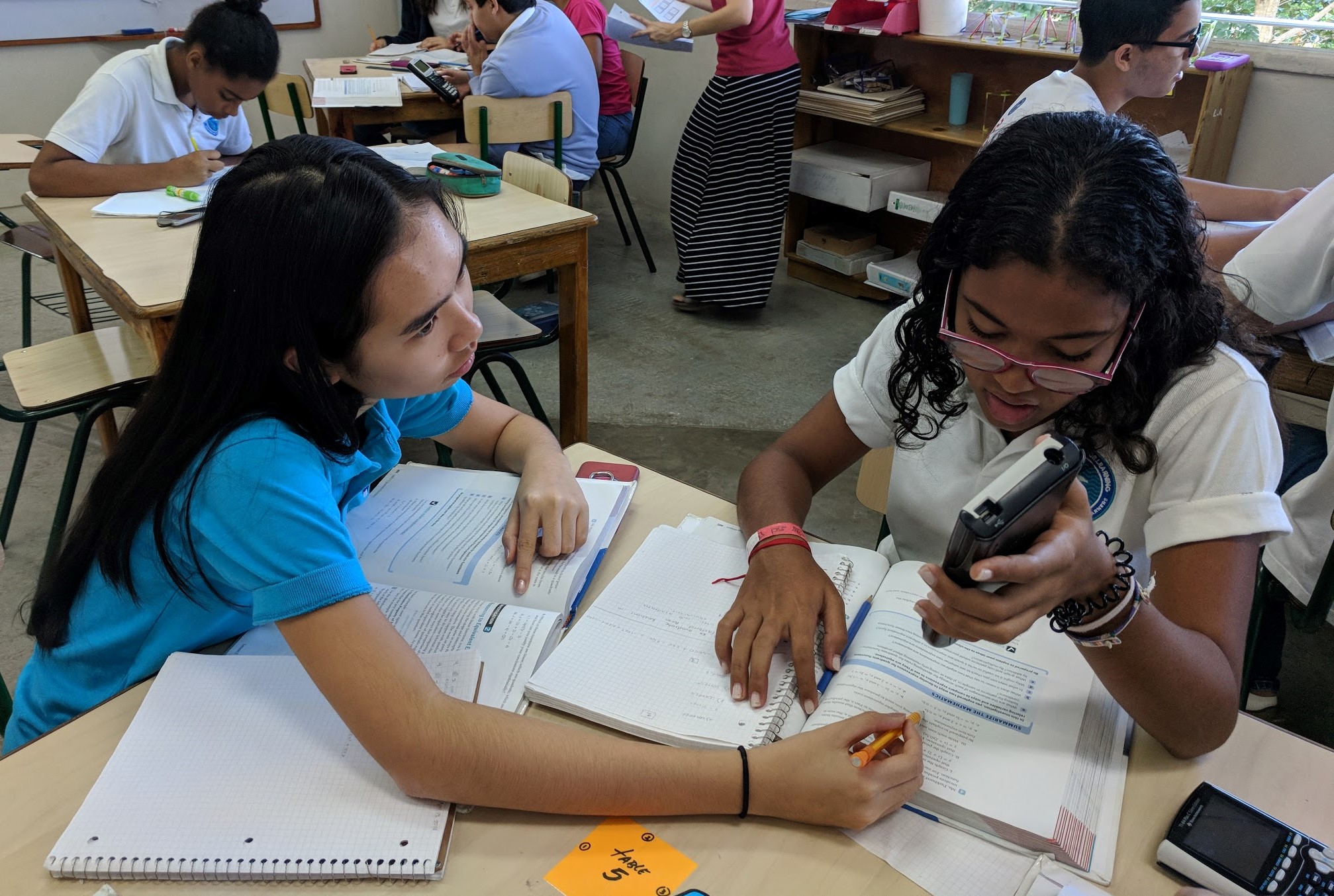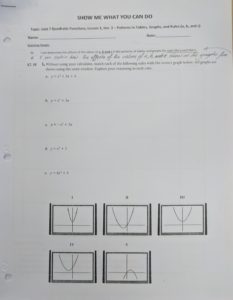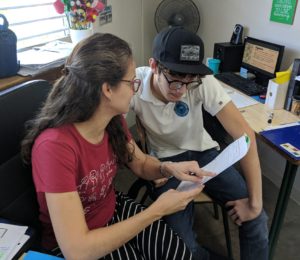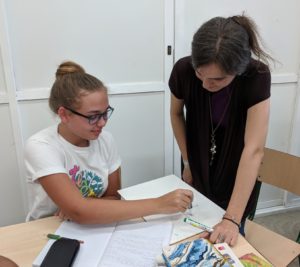Going Gradeless in Math Class
About a month ago, I read Andrew Bernett’s blog post How to Create a Gradeless Math Classroom in a School That Requires Grades. Andrew explains how he decided to get rid of “quizzes” and “tests” and instead use a style of assessment that he called “show me what you can do” (SWYCAD). He let students know that they would have many opportunities to show mastery of the material being covered. When marking the SWYCADs, he gave feedback but no grades. Students then used the feedback to self-assess their understanding of the learning targets being covered.
His ideas sounded like a great way to empower students, so I sent his article to Rachid, the head of our math department, who responded with his signature “let’s do this!” attitude. That week, he met with the school’s math teachers and introduced Andrew’s ideas to them. I dropped by the meeting and heard a buzz of excitement: teachers were inspired by the article and were discussing the changes they could make in their classes. Our 9th grade math teachers, Aylin and Shantal, decided to pilot the idea with their students. They began planning together with mixed emotions of apprehension and enthusiasm. The idea sounded good in theory, but how would their students react?
Prepping for the new assessment method
- The teachers realized that the quizzes and tests they had been giving covered far too much information in one go and overwhelmed their students. They decided to make their assessments shorter so that they only covered 1 – 3 learning targets and would take only about 10 – 15 minutes to complete. By breaking the information down into smaller chunks, it was easier for the students to digest, and their performance improved.
- As students self-assessed, the teachers realized they needed to tweak their learning targets to make sure they really expressed what they wanted students to know. For instance the target, “I can determine the effects of the values of a, b, and c in the patterns of tables and graphs for rules like y=ax2+bx+c” had to be changed to “I can explain how the effects of the values….” They wanted students to be able to show the values on a graph, but they also wanted them to be able to explain why the equations worked the way they did.
- Aylin and Shantal found that to teach effectively, they needed to fine-tune their work to decide what students really need to know. They used to have too many different learning targets — sometimes a different one each day. Now, however, with their more specific, well-thought-out objectives, they’re consistently working with the same 5 or 6 targets per unit. That way, on a daily basis, students can self-assess their understanding of the targets that will show up on the SWYCAD.
How the class runs
- At the beginning of each class, students assess themselves on the learning target they’re covering at the moment, and then re-assess themselves at the end of class to see how much they’ve progressed. For now, Shantal and Aylin are using the self-assessment scale that they’ve had in place for the past few years, but they will be tweaking it based on student feedback.

-
At each table, students work together to find the solutions to different math problems (explorations). Although our math classes have always stressed teamwork, the teachers noticed that the focus used to be on “finishing.” Now, instead of working to get things done, students are working to understand.
- When students finish an exploration, they go check the answers (teachers leave these available on a desk). They’re constantly self-assessing. If they don’t understand why they made a mistake, they ask for help. Getting the right answer is no longer the objective — understanding how to get the right answer has become the focus.
- After students take the SWYCAD, teachers mark the work and give them feedback. Students then use the feedback to self-assess. If teachers don’t agree with the self-assessment, they meet with the students for a conference to discuss it. Although a few students grade themselves too high, most of them tend to be too hard on themselves.
The outcome
-
Less stress. The students are relaxed, which has a positive effect on their ability to learn. The ambiance of the class has changed drastically. Aylin says: “It’s a symbiotic relationship. They feel less stressed, so we feel more relaxed. Our tone is more gentle and they trust us more. What amazes us is that this change happened so quickly!”
- Little homework. Teachers have noticed an enthusiasm for learning: students come into class asking, “What’s the learning target? What are we doing today?” and they’re eager to get started. Because they’re more engaged, most of them finish their work in class and only a few of them have homework.
- Focus on learning. The focus has changed from “getting good grades” to truly understanding. Teachers no longer have to worry about students copying from each other, since students know that they need to be able to explain both their solutions and their mistakes very specifically. They can’t do this if they simply copy the answer from someone. Now that students know that they’re in control of their grades, they feel empowered over their own learning.
- Growth mindset. Students are starting to realize if they truly understand a concept or not, and they’re willing to work hard until they master it. They’re showing improvement on learning targets that are repeated from one SWYCAD to the next. And not only do they feel proud of their improvements, but they’re developing a growth mindset as they realize that, with effort, they can learn.
- Improved grades. Students are taking their learning seriously. All of them are doing much better and so far no one has needed a retake of an assessment. In the 9th grade, about eight students used to consistently fail assessments, in spite of extra help in class and one-on-one tutoring. Since starting this experiment, the lowest overall grade so far is 88% and the class average at the moment is 94%!
When I met with the teachers to see how things were going, Shantal mentioned:
I have to admit, I was skeptical at first. I thought it was going to be much more work on our part and I was worried that students wouldn’t take their work seriously. At the beginning it felt overwhelming, but it turned out to be easier than I expected. Learning targets were modified on a daily basis and the process felt natural. I wasn’t sure that the kids would rise to the occasion, but they went above and beyond. It was surprisingly positive.
Reflecting on how this has changed her as a teacher, Aylin said:
Everything we’ve been working on in professional development — learning targets, checking for understanding, and feedback — it all comes together for me now. You can’t do this without strong learning targets in place. The lesson we had on referring to learning targets in our classes used to be so hard for me. I’d have to really make a concerted effort to remember to refer to the learning target. Now it’s just natural. When a student asks me a question, I automatically say ‘Let’s look at the learning target. What do you think? What’s missing in your work?’ It’s constant. We check for understanding and so do the students. They’re self-assessing using my feedback, so the feedback has become more meaningful now. It’s a cycle and it’s all necessary. Suddenly everything I’ve learned in the past two years is coming together and making sense. Shantal and I are also part of the process — we share our experiences and constantly give each other feedback. Our work actually feels easier now, and so much more meaningful.
The big takeaway from the gradeless math class: students feel empowered and so do teachers. The enthusiasm is contagious and the kids are learning. What more can we ask for?





This is awsome !!! Thanks for sharing
Carla – this is an inspriational post! Thank you for sharing (and as always – passing it on!)
As a mother of a 9th grader (who has always loved Math) I want to share my son´s comments about this. He got into the car and said, “Math class is even better now, it’s a lot more relaxed, we’re being evaluated but you don´t feel like it, there´s no pressure. Even the people who have always struggle with Math are doing much better. I really like the way we’re doing ‘quizzes’.” Good for you and your dedication to research and applying new strategies!!
Thank you so much for sharing your son’s comments, Odile! This kind of student feedback is gold! It lets us know when we get something right or if we need to make changes!
I am teaching 3rd grade math this year. I would to implement something like this this year. I am curious what the “math problem explorations” look like in your class. What does the flow of your lesson cycle typically look like?